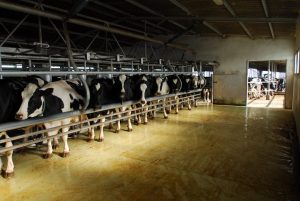
Combine those high temps with a high humidity index, and dairy cows will get heat stressed. Dr. Glenn Holub is the executive technical service manager of dairy for Phibro Animal Health. Aside from the obvious animal welfare factor, Dr. Holub talked about why dairy producers should worry about heat stress.
“What happens commonly, it seems, on farms is that heat stress seems to come on quickly, and we know we should anticipate it,” Dr. Holub said. “But that heat stress can cost a dairy producer up to $264 per cow. And because the metabolic rate is high in lactating and high-producing animals, those cows are among some of the most susceptible farm animals that we have to the effects of heat stress. It can affect the cows on the cellular level, and that ends up reducing production and reproduction. It’s important to have heat abatement measures in place before heat stress starts to keep the cows comfortable, and that’s before the Temperature Humidity Index, or THI, is above 68.”
Dr. Holub also talked about some immediate abatement measures producers can take during heat stress.
“It sounds obvious, but shade is the most important way to help dairy cows and all animals of all ages avoid the effect of heat stress because shade reduces about half of that cow’s heat load from radiational heating. Airflow is very, very important. So, ventilation, having fans blowing at a rate of ten miles per hour. You’ll want to consider misters or sprinklers, but you have to make sure you have the timing right so that you’re not creating a damp or humid environment that’s conducive to diseases like mastitis. You’ll also want to probably look at spacing. How many square feet are you providing per cow to get them to spread out a little bit.”
Dr. Holub said nutrition plays a key role in combating heat stress.
“Nutrition plays two roles,” Dr. Holub said. “Number one is the management of putting feed out in front of the cows and then the nutritional strategy that you might use. Cows tend to eat more during the cooler parts of the day during the hot summer months, so you’ll want to make sure you have the most feed available then. Heat-stressed cows drink up to twice as much water as cows that are not heat stressed. That means a large-bodied cow can drink up to 55 gallons of water each day. But we want to make sure that we have plenty of access to clean, fresh water. Producers also want to add to their feed some positive cations, such as potassium, to balance the electrolytes.”
A healthy immune system can offset the effects of heat stress, so Dr. Holub said there are several benefits to using Omnigen Nutritional Specialty Product.

“Cows produce a large amount of metabolic heat,” Dr. Holub said. “So, when we add heat stress from the environment to the mix, we’re just asking for problems if we’re not supporting that immune system. So Omnigen Nutritional Specialty Product has been proven by research to help support healthy immune function because that research has shown that heat-stressed cows that are fed Omnigen have lower respiration rates and rectal temperatures, which are two of the key indicators of heat stress. We also see the greatest benefit of feeding Omnigen before you hit a heat-stress swamp. Bear in mind that heat stress occurs gradually and likely earlier than we think.”
For more information, visit theomnigendifference.com. You can also download a free webinar called “Dairy’s Most Profit-Draining Challenges – Heat Stress” on the Phibro Academy website at academy.pahc.com.
























